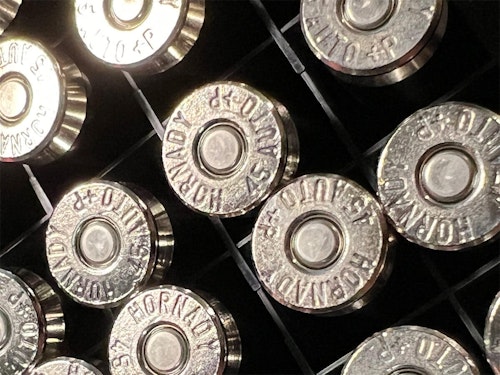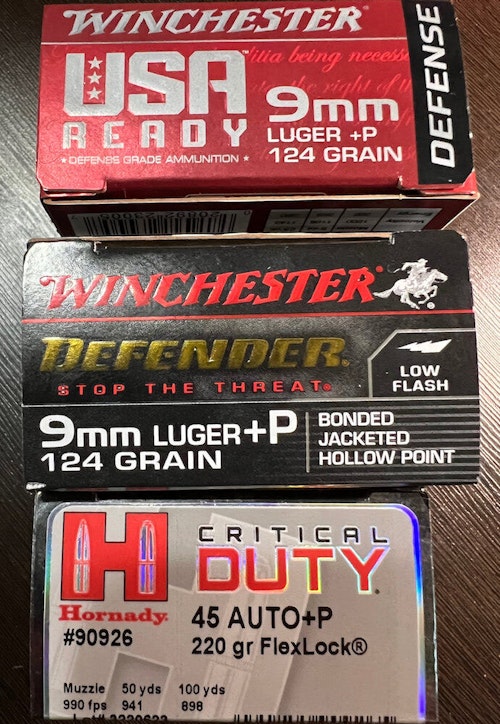Selling a gun involves answering a lot of customer questions. One of the most common questions has to do with ammo selection.
Customers see the large variety of options and confusion sets in. You’re going to need to educate them about the different types, bullet weights, etc. so they can make informed decisions in the future. Not only do you need to know the differences, you’ve got to be able to explain them in terms that even a novice will understand. That’s the most important task of being a professional in the gun industry.
Many customers go to your gun store and purchase their ammunition based on price. They match the caliber to the weapon they have then look for the cheapest thing they can get. If purchasing ammo for practice, there’s nothing wrong with that approach. The cheaper the price, the more ammo they can buy and the more practice they can get. But that approach might not be the best when purchasing ammo for defensive use.
There are a lot of considerations when choosing carry ammo. Their choice is going to vary based on the expected environment where they are most likely to use it. In a very cold climate where assailants may be wearing bulky clothing, penetration is a major factor. If the ammo is intended strictly for home defense, over-penetration might be a liability. Decisions must be made on what is best for a particular use. One common source of confusion is the designation of +P or +P+ they see on the boxes. Let’s look at these terms and what it all means for your customers.
It's no secret. It is the pressure inside of a fired cartridge that pushes the bullet down the barrel and on its path to the intended target. Too much pressure can be catastrophic. Too little pressure, and the bullet might not exit the barrel, setting up another dangerous situation. To prevent these issues, SAAMI (Sporting Arms and Ammunition Manufacturers’ Institute) was established to create and maintain records of cartridges and chambers. They set the standards. Those standards include the recommended pressure and max pressure for a particular caliber. The +P and +P+ designation simply means that the cartridges have pressures that are over the industry standard.
Man (being what he is) is always looking to climb higher, race faster and build things bigger. Such is the case with ammunition. When smokeless powder replaced blackpowder, it provided a variety of burn rates that permitted experimentation. It didn’t take long for people to begin creating their own loads and even new calibers. The race was on to find the perfect cartridge. It is still with us today.
Getting more performance from a bullet usually means increasing the chamber pressure. Increased pressure means faster bullet velocities, higher energy and increased penetration. The most common way to accomplish this is to increase the powder charge. Adding more powder in the same case volume is quick and easy. This isn’t the only way. Manufacturers can choose different primers, powders, bullets, and even seating bullets to different lengths. These are but a few measures used to change pressure. Factory ammo that is loaded in excess of the standard pressure are designated as +P (Added Pressure) and +P+ (Added Pressure Plus a Little More). There’s likely a technical term for these, but I find these descriptions to be accurate and easily understandable, so I take descriptive liberty here for the sake of clarity.
The first thing to know about +P ammo is that there is no set standard for what a manufacturer designates as +P. Typically, it’s about a 10% increase in pressure, but it could be as high as 30% (depending on caliber). SAAMI does specify a recommended value for standard ammunition and +P loads, but manufacturers can vary from that based on their own desired result.
Unlike standard and +P ammunition, +P+ ammo has no such recommendations. The loads and pressures are completely up to the manufacturer. It is typical for these to be about 10% above the +P loads. The only limiting factor is the maximum pressure for that caliber. Rounds loaded to the maximum pressure are called Proof rounds and are only used for firearms testing purposes. Most guns are required to fire a proof round before being sold to ensure they are safe.
The pressure increases typically result in about a 100 fps jump in bullet velocity. That doesn’t seem like much, but it could be the difference in penetration that’s needed for barriers or heavy clothing. It could mean the difference in bullet expansion and quick incapacitation of a threat. Note that a 10% increase in bullet velocity translates into a 21% increase in energy. More energy means more stopping power.
Your customers may ask, “What’s the point?” There are a lot of brands with highly-rated standard-pressure ammunition. We’ve already mentioned that the +P loads provide extra penetration and energy, and stopping power, but there are other reasons one might consider them. Those who choose to carry a short-barreled handgun may want the added velocity to compensate for the shorter barrel and its accompanying velocity losses. A bullet fired from a 4-inch barrel develops quite a bit more velocity and energy than one from a 2-inch barrel. The power increase also translates into less bullet drop at a given range.
Added benefits always have added cost. While +P ammo is more expensive, this is not the cost I’m referring to. Increased bullet velocity also translates to increased slide velocity on semi-autos, adding stress to the slide and frame, the firing pin, and springs. That take a toll on guns — especially older ones or those with lots of previous use. Last, overpressure ammunition has a significant increase in recoil. That might be enough to discourage people who are recoil sensitive to avoid them.
It's important to note that +P ammo cannot be used in all guns. Most modern pistols and revolvers are made to support the added pressures, but not all of them. The customer should always consult the owner’s manual before using overpressure ammo. Alternate sources of information would be the manufacturer or qualified gunsmiths. If in doubt, do not use +P or +P+ loads. It’s always better to be safe rather than sorry.
If all the information on velocity, pressure, benefits and hazards are too much to worry over, never fear. There is plenty of ammo out there to choose from. Speer’s Gold Dot and Federal’s HST are two brands that are popular with law enforcement across the country. Both are known to provide excellent results in duty environments. Logic dictates that if these are good enough for law enforcement, they should be good enough for defensive loads. There isn’t a need to use overpressure ammo. It’s an option and should be based on circumstances.
It's easy for those who have been using guns for years to assume that the specialized knowledge that we have is known to all. It’s easy to assume your customers already know about ammunition, but that’s not the usual situation. Take the time to point out different types of ammo and explain what the numbers and symbols mean. You’re going to find that most customers will appreciate the added service and attention and will thank you for your professionalism.








